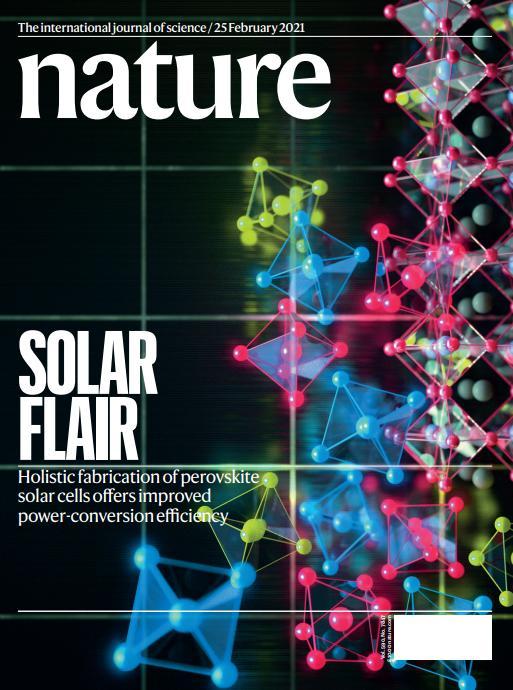
The front page of Feb. 25 issue of science journal Nature shows the research on the next-generation perovskite solar cells conducted by the Korea Research Institute of Chemical Technology. (Korea Research Institute of Chemical Technology)
A next-generation solar cell developed by South Korean research team made the cover of leading science journal Nature, according to the Korea Research Institute of Chemical Technology on Thursday.
The institute’s research team led by Seo Jang-won developed a perovskite solar cell that demonstrates an efficiency rate of 25.2 percent. The efficiency rate indicates the proportion of solar energy converted into usable energy.
Perovskites are easily synthesized compounds with an orthorhombic crystal structure. Perovskite solar cells use micrometer-thin films made of these materials to harvest light.
The cells have recently gained attention for their enormous potential. The efficiency of silicon-based solar cells in the market maxes out at 26.7 percent. Perovskite cells are expected to breach that barrier.
According to Hyundai Motor Securities analyst Kang Dong-jin, perovskite solar cells, though 100 times to 200 times thinner than silicon-based solar cells, can absorb the same amount of sunlight but generate more electricity, making them light and flexible, as well as efficient. In terms of the manufacturing process, silicon-based solar cells require higher temperatures -- above 1,000 degrees Celsius -- while perovskite solar cells can be manufactured at between 150 and 200 degrees Celsius, which translates into a significant cut in manufacturing costs.
“In theory, perovskite solar cells can exhibit efficiency rate up to 80.5 percent. With further research, they will be able to overcome the maximum efficiency rate of 26.7 percent of silicon-based solar cells,” Dr. Seo said.
Seo added that his research team dramatically lowered the manufacturing temperature of perovskite solar cells to 150 degrees Celsius from 500 degrees Celsius.
By Kim Byung-wook (
kbw@heraldcorp.com)






![[Graphic News] More Koreans say they plan long-distance trips this year](http://res.heraldm.com/phpwas/restmb_idxmake.php?idx=645&simg=/content/image/2024/04/17/20240417050828_0.gif&u=)